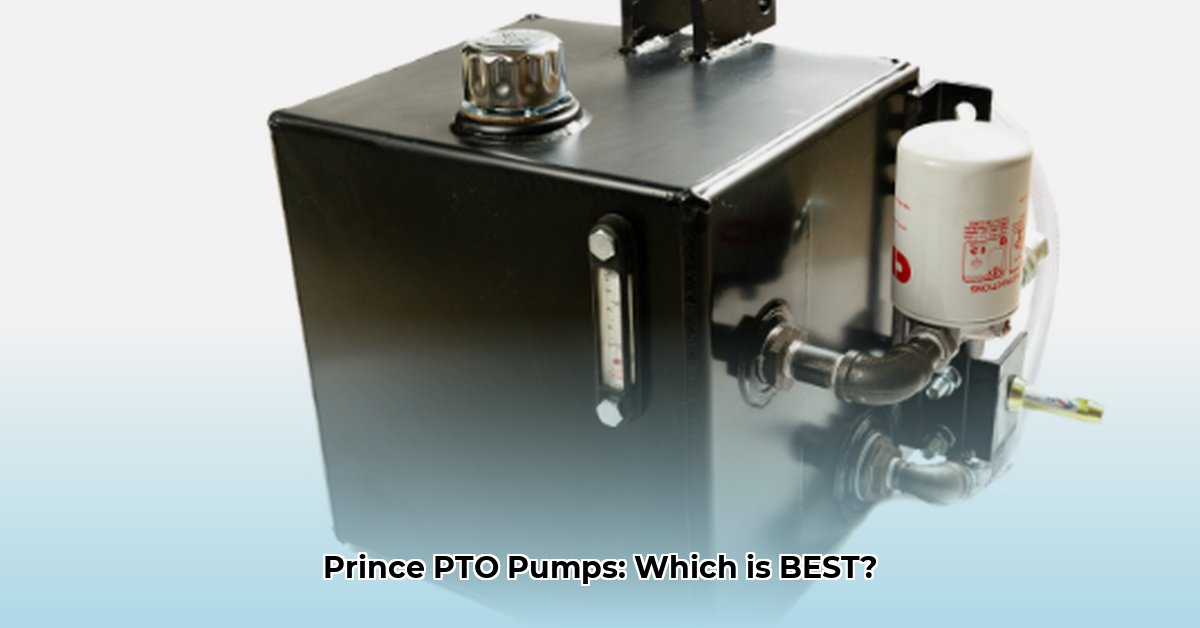
Choosing the right power take-off (PTO) hydraulic pump is crucial for efficient and reliable farm operations. This detailed comparative review focuses on two Prince models, highlighting their features, performance characteristics, and maintenance needs to guide you towards an informed purchasing decision. While complete specifications were not readily available from online retailers, this review emphasizes the importance of contacting Prince directly for comprehensive data before making a purchase. For more information on hydraulic system maintenance, check out this helpful resource on hydraulic filter maintenance.
Understanding Prince PTO Hydraulic Pumps: A Deep Dive
This comparison analyzes two Prince PTO hydraulic pumps—let's call them Model A and Model B—to help you choose the best option for your farm. We'll examine their strengths and weaknesses based on available information, acknowledging the limitations of incomplete data. Remember: always verify specifications directly with the manufacturer before purchasing.
Specifications: A Head-to-Head Comparison
Obtaining complete specifications proved challenging. The following table summarizes the available information; significant gaps exist and are noted. Contacting Prince directly is crucial to fill these gaps.
| Feature | Prince Model A (Source: Northern Tool - Incomplete Data) | Prince Model B (Source: Amazon - Incomplete Data) | Important Notes |
|---|---|---|---|
| Flow Rate (GPM) | 21 (Incomplete Data: Pressure at various PTO speeds missing) | Not Listed (Requires Manufacturer Contact) | Indicates the volume of hydraulic fluid pumped per minute. Higher flow rates enable faster work. Critical for matching equipment demands. |
| Maximum Pressure (PSI) | Not Listed (Requires Manufacturer Contact) | Not Listed (Requires Manufacturer Contact) | Indicates the force the pump can deliver. Insufficient or excessive pressure can damage equipment. Crucial for proper equipment function. |
| Material | Cast iron (Likely includes aluminum components) | Not Listed (Requires Manufacturer Contact) | Material selection significantly impacts pump durability and lifespan. Cast iron is generally more robust; aluminum is lighter but potentially less durable. |
| SAE Port Compatibility | Yes | Yes | This ensures compatibility with standard agricultural implements. |
| Self-Adjusting Plates | No | Yes | Self-adjusting plates compensate for wear, reducing friction and extending pump lifespan. A significant advantage in terms of maintenance and longevity. |
Feature Comparison: Key Differences and Their Implications
Both pumps likely employ a reliable gear-type design. However, a critical difference emerges: Model B incorporates self-adjusting wear plates, a significant advantage regarding maintenance and longevity. These plates automatically adjust to compensate for wear, minimizing friction and extending the pump's operational life. Model A, while likely using robust materials, lacks detailed information regarding its long-term durability. Therefore, the complete lifespan comparison between them is impossible without more information.
Performance Analysis: The Need for Detailed Manufacturer Data
A major limitation of this comparative analysis is the lack of readily available performance data. Neither product description provides crucial information, such as pressure output at varying PTO speeds. This data is essential for correct pump sizing and matching it to intended implements. Directly contacting Prince for comprehensive performance specifications is absolutely necessary.
Maintenance Considerations: A Comparative Overview
Regular maintenance is crucial for extending the lifespan of any hydraulic pump. Gear pumps typically require periodic checks for leaks, wear assessment, and fluid condition monitoring, often involving filter changes. The frequency of these checks and potentially costly component replacements depends heavily on pump usage and environmental factors. Model B's self-adjusting wear plates are likely to reduce the frequency of maintenance interventions needed compared to Model A, given their self-compensating nature resulting in less friction.
Installation and Compatibility: Ensuring Seamless Integration
Proper installation is critical to avoid pump failure and potential damage to your tractor. Consult both the pump's and your tractor's manuals meticulously. Ensure compatibility between the pump's PTO shaft specifications and your tractor's PTO output. Incorrect installation can lead to premature wear, leaks, and even catastrophic failure. Additionally, proper reservoir sizing is essential to prevent cavitation, which can seriously damage the pump and other components. A sufficient reservoir size, at minimum larger than the pump’s flow rate will significantly reduce this risk.
Buying Guide: Choosing the Right Pump for Your Needs
Based on the currently available (incomplete) information, Model B, with its self-adjusting wear plates, appears to offer advantages in maintenance and longevity. However, this conclusion hinges on the assumption of similar overall durability between the two models, something which remains unverified. The lack of complete specifications for both models significantly limits the ability to confidently recommend one over the other. Therefore, acquiring detailed manufacturer specifications from Prince is paramount before making a purchasing decision. This is especially critical when buying expensive equipment like a PTO hydraulic pump.
Actionable Steps: How to Obtain Complete Pump Specifications
To ensure an informed decision, follow these steps:
- Verify Model Numbers: Confirm the exact model numbers of the Prince pumps under consideration.
- Locate Manufacturer's Website: Access Prince's website and search for technical specifications or documentation.
- Request Specifications: If necessary, contact Prince's customer support to directly request the complete specifications.
- Carefully Examine Data: Pay close attention to maximum pressure, flow rate at various PTO speeds, material composition and any other relevant information.
This review serves as a starting point. Always rely on official manufacturer data sheets to make a confident, informed purchasing decision for this important piece of your equipment. This is a significant agricultural investment and should never be based on incomplete information.